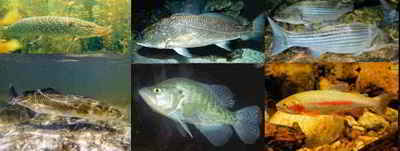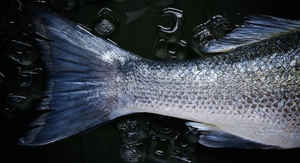
California Symbols
California State Fish
Golden Trout

(Salmo agua-bonita)
Adopted on April 11, 1947
The golden trout, (Salmo agua-bonita,) is native only to California and was named the official state fish by act of the State Legislature in 1947. The California golden trout (also known as Volcano Creek golden trout) are in the most precarious position of the three golden trout. They are found in Golden Trout Creek, a tributary to the Kern River, and the South Fork Kern River, which empties into Lake Isabella.
South Fork Golden Trout (Blue Book p.23) Designated in 1947 (This information was listed in the California Blue Book of 1975. However, it is not mentioned in the Government Code section on State Emblems, 2000.)
California State Fish: Golden Trout

The California golden trout,
or simply the golden trout (Oncorhynchus mykiss aguabonita), is a subspecies of the rainbow trout native to California. The golden trout is native
to Golden Trout Creek (tributary to the Kern River), Volcano Creek (tributary to Golden Trout Creek), and the South Fork Kern River.
The California golden trout is closely related to two other rainbow trout subspecies. The Little Kern golden trout (O. m. whitei), found in
the Little Kern River basin, and the Kern River rainbow trout (O. m. gilberti), found in the Kern River system. Together, these three trout
form what is sometimes referred to as the "golden trout complex".
Characteristics of the Golden Trout
A brilliantly colored fish, the golden trout has bright red markings on its sides, underbelly, and cheeks. Along its spine, dorsal and caudal fins, are large, black spots. The waters at the elevation where the trout are found are very cold and very clear with a high reflective rate. The Golden Trout in particular has adapted very well to this environment in terms of appearance. This trout adapted a yellow gold to olive green tint on its sides and belly. The fish also developed two very brilliant red stripes; one on its belly which runs from the last lower fin to the front of the gill, the other stripe is on the lateral line that typically begins at the seventh lateral spot which also runs to the gill. These colors were adapted for both passive and aggressive reasons. The gold and red, when viewed from out of the water, make the trout virtually invisible in the shallow creeks of the high Sierras. Having this advantage makes it difficult for predators and prey alike to locate it. Golden Trout are an average length of five to seven inches. Golden Trout of ten inches have been recorded, but they are rare. Its body's depth is 3.5 inches with noticeably small scales . The fins have small, black spots with a black border with white tips. Golden Trout have more spots on their back and tail than your average Rainbow or Brown Trout. Native trout of all species typically have seven to ten large black circles along their lateral. The rule is the more predominant the "spots," the closer to native blood the individual trout is. Typically, the purest Golden Trout have the largest lateral spots and the brightest colors. Knowing this helps the observer decipher between a native and nursery or hybridized trout.
Habitat

Originally the species was found only in a few streams in the icy headwaters of the Kern River, south of Mount Whitney, the highest peak in the United States outside of Alaska. Stocking of wild and hatchery-reared fish has extended its range to many waters at high elevation in the Sierra Nevada from El Dorado and Alpine Counties southward. The golden trout was originally found only in the waters of the Kern River in the southern San Joaquin Valley. Later it was introduced to mountain streams throughout other states.
California Assembly Concurrent Resolution No. 52
Assembly Concurrent Resolution No. 52, designating the official state fish and pisifaunal emblem, was introduced on March 20, 1947 by Assembly member Thomas M. Erwin.
Assembly Concurrent Resolution No. 52
CHAPTER 90
[Filed with Secretary of State April 14, 1947]
WHEREAS, California is justly famous throughout the world for her multiple and varied industries and as a wonderland of natural resources both rich
and beautiful; and
WHEREAS, Many flora and fauna of California are distinctive that they are generally recognized as native to this State and associated with the name
of California; and
WHEREAS, From time to time the people of this State have expressed their pride in these distinctive creatures by designating them official symbols
of the State of California, as for instance, in 1903 the golden poppy was designated the official state flower, in 1931 the valley quail the official
state bird, and in 1937 the redwood the official state tree; and
WHEREAS, The golden trout of California is widely known as a distinctive and unusual native of this State; now therefore, be it
Resolved by the Assembly of the State of California, the Senate thereof concurring, That the California golden trout (Salmo aqua bonita) is
hereby designated the official state fish and piscifaunal emblem of this State.
California Law
The California golden trout was adopted by Assembly Concurrent Resolution No. 52 and is not listed in the California Government Code alongside other symbols and emblems.
Taxonomic Hierarchy: Golden Trout
Kingdom: Animalia - animals
Phylum: Chordata
Class: Osteichthyes
Order: Salmoniformes
Family: Salmonidae
Genus: Salmo
Species: Salmo agua-bonita
Today, the California golden trout is classified as Oncorhynchus mykiss aguabonita.







